Fishing for novel cellulose degraders
Date: 25.12.2019
One of the most vital pieces of equipment for fly fishing is a boxful omají f lures. Designed with feathers or wires to mimic an insect or a particular movement, each of these lures are the bait designed to attract specific catches. A similar technique has been developed by researchers led by Tanja Woyke at the U.S. Department of Energy (DOE) Joint Genome Institute (JGI).
 Using a single-cell screen, they can now identify microbes with specific functional characteristics. When they tested the screen method on a microbial community from geothermal hot springs, they uncovered a novel cellulose-degrading bacterium typically found in low abundances.
Using a single-cell screen, they can now identify microbes with specific functional characteristics. When they tested the screen method on a microbial community from geothermal hot springs, they uncovered a novel cellulose-degrading bacterium typically found in low abundances.
This study shows how the function-driven, single-cell screen can uncover more about cellulose-degrading microbes. The new technique is another tool for microbial ecologists to learn more about the diversity of microbial enzymes, which could have a plethora of potential applications to industrial processes.
JGI researchers developed a function-driven, single-cell screen that they described as a "hook and bait" approach to isolate cellulose-degrading microbes. They first bound single microbes to fluorescently labeled cellulose particles that served as the "bait," and then they isolated the particles through the "hook" of fluorescence-activated cell sorting to sort cells into several small pools, followed by whole genome amplification and shotgun sequencing.























